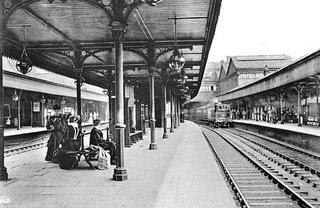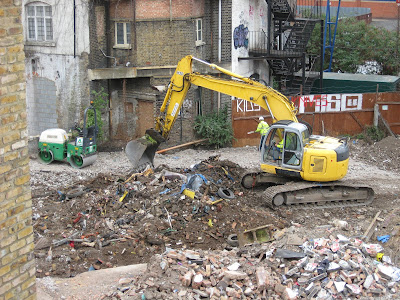The recent story of the Eastern Curve spans 150 years. And now, once again, it is attracting a lot of attention as you can see here and here. The Eastern Curve Garden and the pavilion - a new public space in the heart of Dalston
The Eastern Curve Garden and the pavilion - a new public space in the heart of Dalston
The Eastern Curve was where the old railway line from Dalston Junction station tunnelled under Dalston Lane in 1865 and joined up with the North London Overground line running east to Stratford.
A train arrives at Dalston Junction from Broad Street in 1865
But trains haven't clattered along the Eastern Curve in living memory. For decades it has been a forgotten wilderness where the kestrels nesting in St. Marks tower would forage for prey. The deserted building on the development site next door was discovered by a group of graffiti artists who created their contemporary frescos.
But, in more recent years, it had became a site for predation by fly-tippers, dealers and pimps. A land of dereliction and lost souls - with police reporting that people were sleeping in the tunnel and in the derelict, and now demolished, Ashwin Street houses which backed onto the land.
Then, last year, the Eastern Curve became the site for the temporary Dalston Mill designed and built by EXYZT along with a recreation of Agnes Denes' 1982 work; "Wheatfield - A Confrontation". You can see more of the activities at the Dalston Mill here. photo © Exyzt
You can see more of the activities at the Dalston Mill here. photo © Exyzt
After these events, the mill was dismantled, the wheat dug up and taken to landfill and public access was gone. But not forgotten.
Since OPEN Dalston was first formed in 2004 we have campaigned for desperately needed public green space to be created in the centre of Dalston. With plans afoot to re-open the Eastern Curve we pressed,in alliance with other local associations, for community management of the space. Now, after months of planning, of negotiation with landowners and funders, of confidence building between partners, the vision is being realised. The Eastern Curve is becoming a haven for local people and for nature. First came the excavations when a decade of fly-tipping was unearthed, sorted and the ground landscaped and laid out.
First came the excavations when a decade of fly-tipping was unearthed, sorted and the ground landscaped and laid out.
Then work started on creating the pavilion, a covered wooden structure, to host events. Designed by EXYZT, this photo (above) shows some of the team of local people employed to build it.

And now the Eastern Curve Garden is open to all. A place where people meet plants. A place for growth, creativity and solace amidst the hustle and bustle of Dalston Town centre's redevelopment.
The entrance is through the door at back of Dalston's Peace Mural Square. Don't miss out - just go to the Dalston Eastern Curve Garden to see what's happening.
